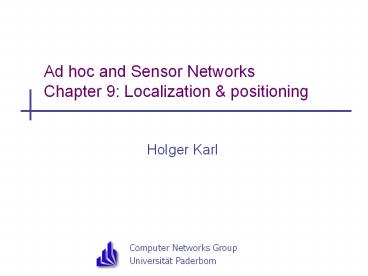Ad hoc and Sensor Networks Chapter 9: Localization & positioning
1 / 19
Title:
Ad hoc and Sensor Networks Chapter 9: Localization & positioning
Description:
Ad hoc and Sensor Networks Chapter 9: Localization & positioning Holger Karl Goals of this chapter Means for a node to determine its physical position (with respect ... –
Number of Views:209
Avg rating:3.0/5.0
Title: Ad hoc and Sensor Networks Chapter 9: Localization & positioning
1
Ad hoc and Sensor NetworksChapter 9
Localization positioning
- Holger Karl
2
Goals of this chapter
- Means for a node to determine its physical
position (with respect to some coordinate system)
or symbolic location - Using the help of
- Anchor nodes that know their position
- Directly adjacent
- Over multiple hops
- Using different means to determine
distances/angles locally
3
Overview
- Basic approaches
- Trilateration
- Multihop schemes
4
Localization positioning
- Determine physical position or logical location
- Coordinate system or symbolic reference
- Absolute or relative coordinates
- Options
- Centralized or distributed computation
- Scale (indoors, outdoors, global, )
- Sources of information
- Metrics
- Accuracy (how close is an estimated position to
the real position?) - Precision (for repeated position determinations,
how often is a given accuracy achieved?) - Costs, energy consumption,
5
Main approaches (information sources)
- Proximity
- Exploit finite range of wireless communication
- E.g. easy to determine location in a room with
infrared room number announcements - (Tri-/Multi-)lateration and angulation
- Use distance or angle estimates, simple geometry
to compute position estimates - Scene analysis
- Radio environment has characteristic signatures
- Can be measured beforehand, stored, compared with
current situation
6
Estimating distances RSSI
- Received Signal Strength Indicator
- Send out signal of known strength, use received
signal strength and path loss coefficient to
estimate distance - Problem Highly error-prone process Shown PDF
for a fixed RSSI
Distance
Signal strength
Distance
7
Estimating distances other means
- Time of arrival (ToA)
- Use time of transmission, propagation speed, time
of arrival to compute distance - Problem Exact time synchronization
- Time Difference of Arrival (TDoA)
- Use two different signals with different
propagation speeds - Example ultrasound and radio signal
- Propagation time of radio negligible compared to
ultrasound - Compute difference between arrival times to
compute distance - Problem Calibration, expensive/energy-intensive
hardware
8
Determining angles
- Directional antennas
- On the node
- Mechanically rotating or electrically steerable
- On several access points
- Rotating at different offsets
- Time between beacons allows to compute angles
9
Some range-free, single-hop localization
techniques
- Overlapping connectivity Position is estimated
in the center of area where circles from which
signal is heard/not heard overlap - Approximate point in triangle
- Determine triangles of anchor nodes where node is
inside, overlap them - Check whether inside a given triangle move node
or simulate movement by asking neighbors - Only approximately correct
10
Overview
- Basic approaches
- Trilateration
- Multihop schemes
11
Trilateration
- Assuming distances to three points with known
location are exactly given - Solve system of equations (Pythagoras!)
- (xi,yi) coordinates of anchor point i, ri
distance to anchor i - (xu, yu) unknown coordinates of node
- Subtracting eq. 3 from 1 2
- Rearranging terms gives a linear equation in (xu,
yu)!
12
Trilateration as matrix equation
- Rewriting as a matrix equation
- Example (x1, y1) (2,1), (x2, y2) (5,4),
(x3, y3) (8,2), r1 100.5 , r2 2, r3 3 - ! (xu,yu) (5,2)
13
Trilateration with distance errors
- What if only distance estimation ri0 ri ?i
available? - Use multiple anchors, overdetermined system of
equations - Use (xu, yu) that minimize mean square error,
i.e,
14
Minimize mean square error
- Look at square of the of Euclidean norm
expression (note that for all
vectors v) - Look at derivative with respect to x, set it
equal to 0 - Normal equation
- Has unique solution (if A has full rank), which
gives desired minimal mean square error - Essentially similar for angulation as well
15
Overview
- Basic approaches
- Trilateration
- Multihop schemes
16
Multihop range estimation
- How to estimate range to a node to which no
direct radio communication exists? - No RSSI, TDoA,
- But Multihop communication is possible
- Idea 1 Count number of hops, assume length of
one hop is known (DV-Hop) - Start by counting hops between anchors, divide
known distance - Idea 2 If range estimates between neighbors
exist, use them to improve total length of route
estimation in previous method (DV-Distance)
17
Iterative multilateration
- Assume some nodes can hear at least three anchors
(to perform triangulation), but not all - Idea let more and more nodes compute position
estimates, spread position knowledge in the
network - Problem Errors accumulate
18
Probabilistic position description
- Similar idea to previous one, but accept problem
that position of nodes is only probabilistically
known - Represent this probability explicitly, use it to
compute probabilities for further nodes
19
Conclusions
- Determining location or position is a vitally
important function in WSN, but fraught with many
errors and shortcomings - Range estimates often not sufficiently accurate
- Many anchors are needed for acceptable results
- Anchors might need external position sources
(GPS) - Multilateration problematic (convergence,
accuracy)































